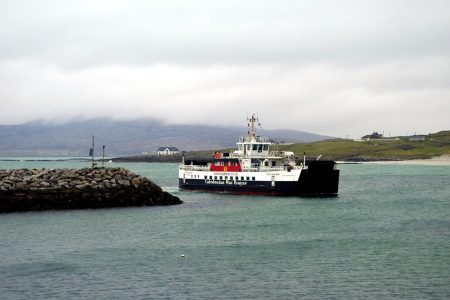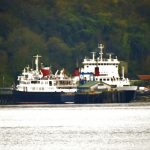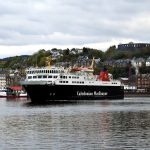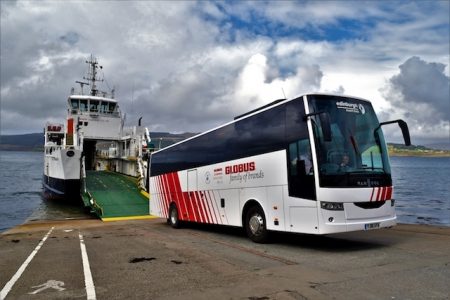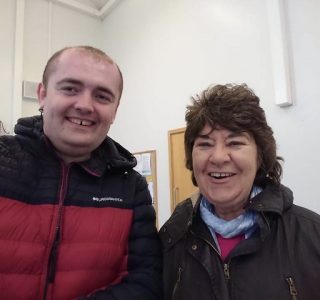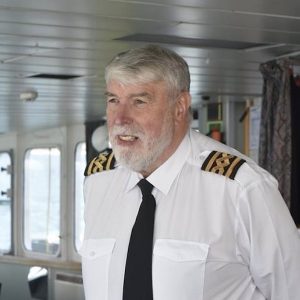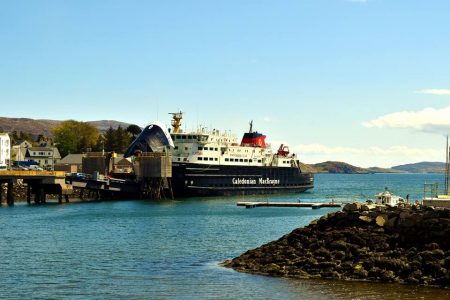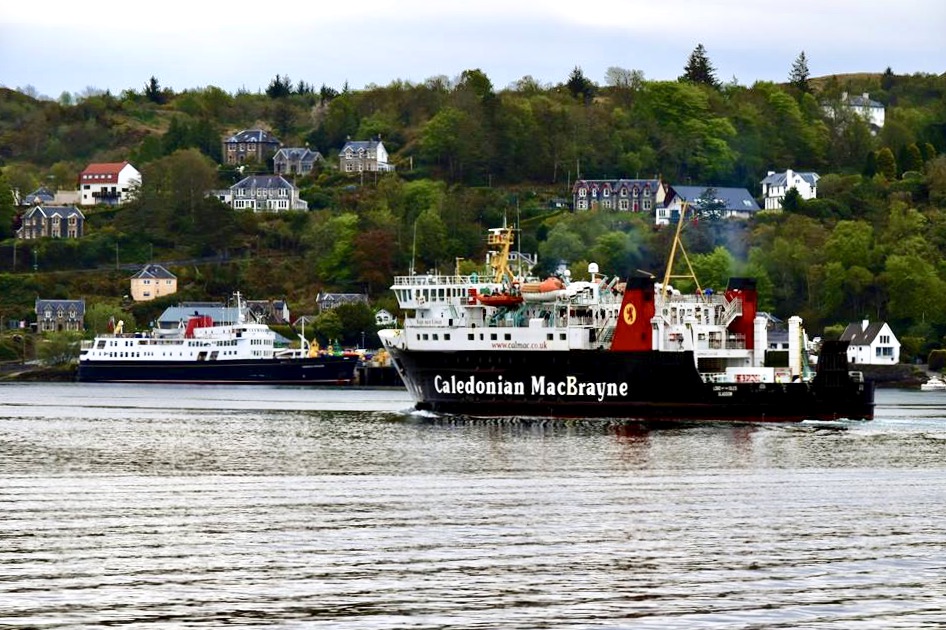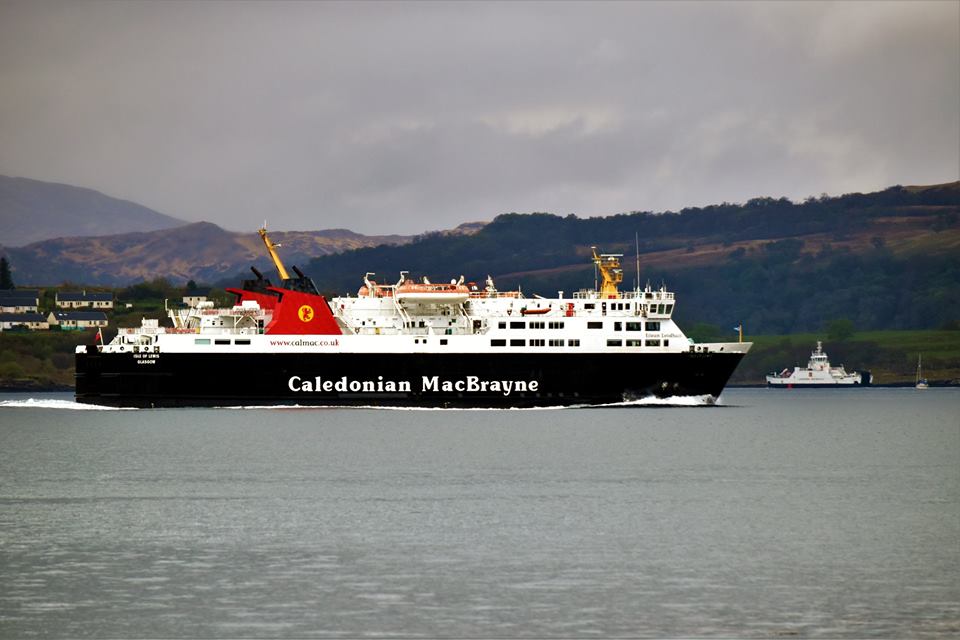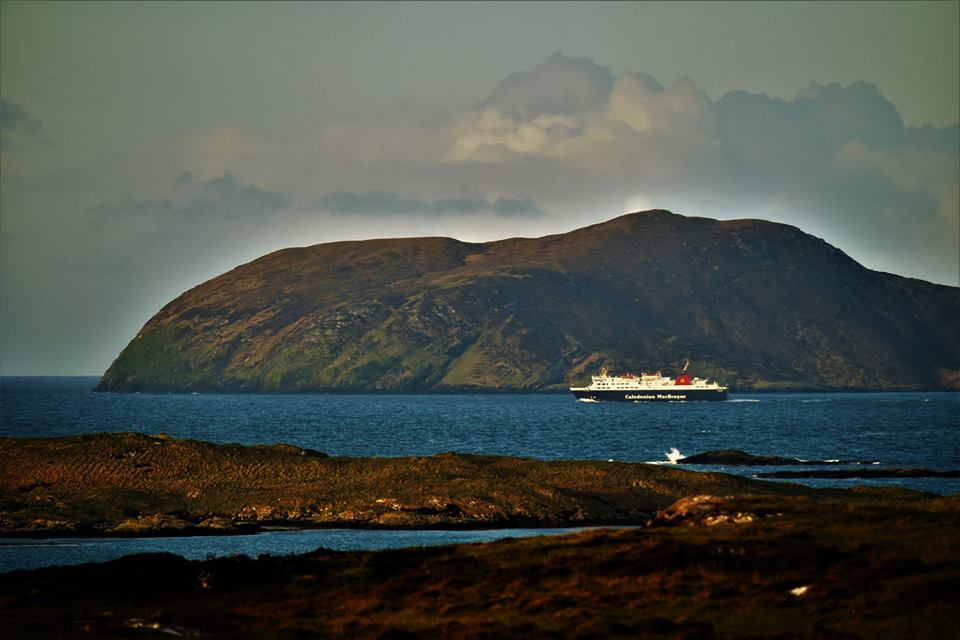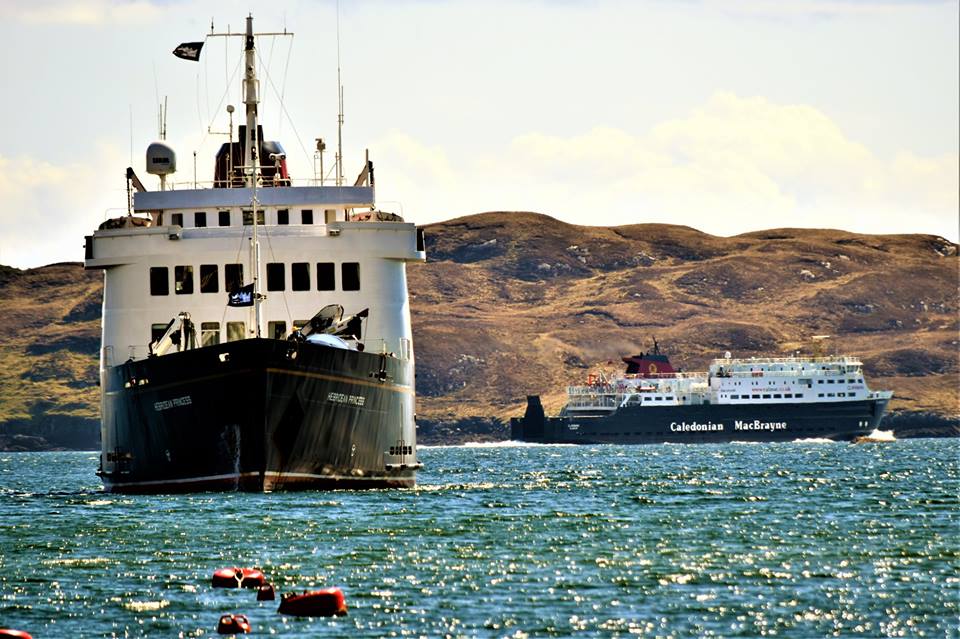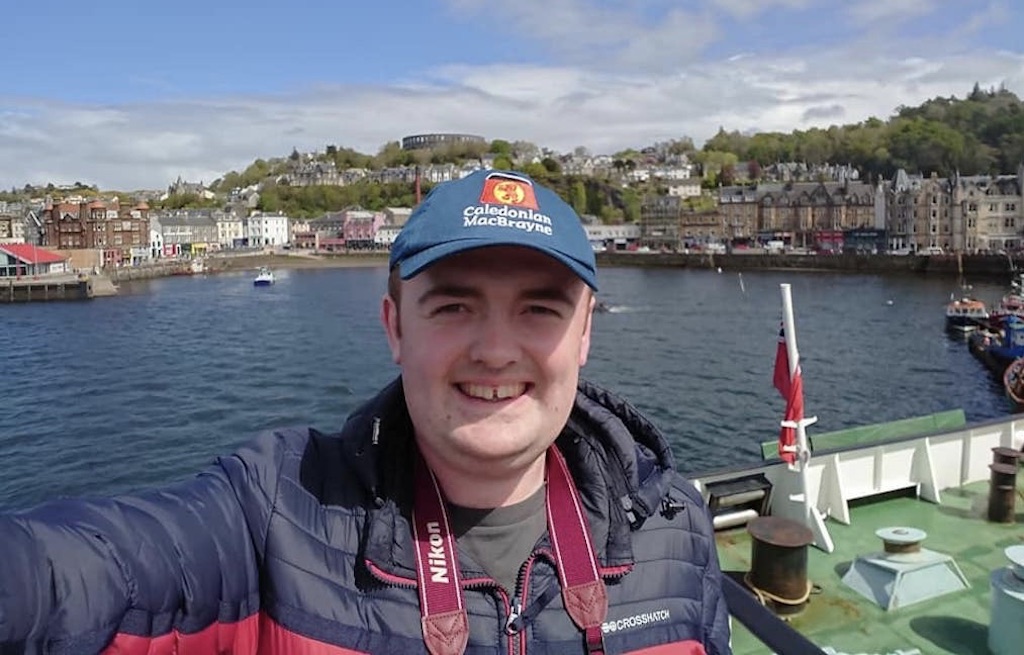
‘The ultimate CalMac adventure’: Mark Nicolson on Isle of Lewis at Oban on 10 May 2018. Copyright Mark Nicolson
Unlike most ship enthusiasts, who travel north to the West Highlands before venturing from the mainland to the islands, CRSC member Mark Nicolson sees cruising opportunities from the opposite perspective — from his home at the northern point of the Outer Hebrides. During his action-packed holiday in May 2018, Mark managed to embrace most routes and ferries on CalMac’s Hebridean network. Here is his account of what happened:
In early May I found myself buzzing with excitement at the prospect of a grand tour of CalMac’s West Highland network. Before leaving home, however, I already knew some spanners had been thrown in the works. Owing to an unfortunate accident to Clansman during her annual overhaul, many changes had been made across the network in her prolonged absence to keep services going.
Lord of the Isles had returned to old haunts at Oban, Coll, Tiree and Colonsay, with Hebridean Isles sailing between Oban and Lochboisdale and Isle of Lewis keeping a normal service going between Oban and Castlebay. This suggested my week’s holiday was going to be varied and even a little unpredictable. In the event, my trip spread across eight days.
Sunday 6 May
Leaving my home village of Back on the island of Lewis at 7am, I made the 62-mile drive in my Vauxhall Corsa south to Harris in time to embark on Loch Portain at Leverburgh for her 0935 sailing across the Sound of Harris.
Loch Portain is one of the largest of the double-ended ferries known as the ‘Loch class’, and regularly tackles one of the most challenging sea routes in the UK, operating across a shallow stretch with small islands in between, zig-zagging several times, with buoys laid out to assist her path. The shallow waters required the vessel to be installed with pump jet propulsion, whereby the water is basically sucked in and pumped back out again. Because of the navigational challenges, the vessel is unable to sail in darkness, so 24-hour operation is not possible.
Loch Portain is a fine and reliable craft with a friendly crew — including Donald Maclean, a Berneray man who is one of the deck assistants. He has been a friend of mine for over a year, and he invited me onto the bridge of Loch Portain shortly before we arrived at Berneray at 1025.
Onward to Lochmaddy, where I took a break from driving to witness Clansman, released from dry dock to relieve Hebrides, on her Sunday morning call, from 1115 to 1145. Her latest survey saw her shorn of lifeboats to make way for Marine Evacuation System inflatable chutes. Following a spot of lunch at Balivanich on Benbecula, I continued via the high eastern and low western land of South Uist to the mile-long causeway to Eriskay, where I awaited Loch Alainn’s 1635 sailing to Ardmhor, Barra. This vessel has been serving the Sound of Barra route since 2007, and the crossing offers some noticeable contrasts to the Sound of Harris service. Her accommodation is on the same level as the car deck, meaning that, unlike on Loch Portain, drivers and passengers have the choice to remain in their vehicles during the 40-minute passage. Loch Alainn uses Voith Schneider propulsion rather than pump jets, and operates a much deeper, more exposed stretch of water, prone to westerly swells coming in from the Atlantic.
It was not long before I found myself in Castlebay, Barra’s main community, with the unmistakable landmark of Kisimul Castle in the bay. Rather than explore this picturesque isle, I decided to photograph the arrival of my favourite ship, Isle of Lewis, despite the unfavourable weather. The timetable for the ferry to Oban — always an early morning departure — required me to spend the night in the village, my choice of accommodation being the recently refurbished Craigard Hotel.
Monday 7 May
Lasting four and three quarter hours, the crossing from Castlebay to Oban is the longest point-to-point service operated by CalMac. I was up at 0530 for Isle of Lewis’s 0755 departure. Heading eastwards past the uninhabited island of Muldoanich, we sailed through thick fog for the first two hours of the journey in the Sea of the Hebrides.
After breakfast in the spacious cafeteria Captain Mark Scott socialised with some of his passengers, including myself. The ship may be large for Barra but she has impressed islanders and tourists alike.
The Sound of Mull area of the route, where you may encounter ferries sailing to Coll, Tiree, Mull and South Uist, offers magnificent scenery on each side, and with vessels in the area providing precious photographic opportunities, it was silly to avoid the open deck before reaching the bustling town of Oban, haven for all CalMac enthusiasts, where we berthed at 1240.
After disembarking I immediately undertook the task of madly photographing as many angles of as many ships as possible, whilst also having the pleasure of meeting fellow CRSC member Colin Smith. After depositing my luggage in the comfortable Oban Bay Hotel, I visited the CalMac terminal to purchase a return ticket for the 1640 sailing to Colonsay aboard Lord of the Isles.
‘Loti’, as she is affectionately known, is probably the most travelled member of the fleet. After exiting Oban Bay by the north channel, we headed down the Firth of Lorn and on to Colonsay: it’s hard to imagine just how remote this island is. Leaving for the return voyage at 1915, I was rewarded with full sunshine and a visit to the bridge, where I chatted to the Third Officer. As we approached Oban, the view to port looking up the Sound of Mull was sublime: moonshine on glassy water was how I would put it.
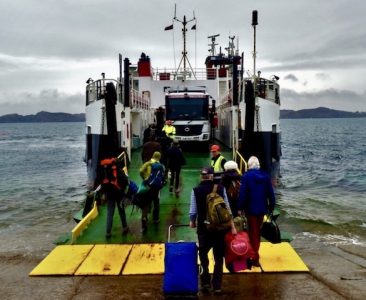
Loch Buie at Iona on 8 May 2018, showing a lorry which had reversed on board. Copyright Mark Nicolson
Tuesday 8 May
Early starts were to be a regular occurrence during this holiday. Gearing up for a day trip to Mull, I took the 0730 sailing from Oban to Craignure aboard Isle of Mull — this year marking her 30th anniversary. Despite Mull being a popular tourist destination, boosted by Road Equivalent Tariff (RET), the island’s roads leave a lot to be desired. The majority are single track with passing places, many of these on awkward bends that require approach with caution.
I chose the 38-mile section to Fionnphort for a quick trip to Iona aboard Loch Buie, enjoying the view of the iconic abbey during the crossing. Unlike most other CalMac vessels, Loch Buie is not a drive-through ferry and has low headroom on her car deck, which is used mainly for residential Iona vehicles. If a tall vehicle needs to cross, it has to be reversed on.
Onwards to Mull’s capital, Tobermory, for the 35-minute hop on Loch Linnhe across the western end of the Sound of Mull to Kilchoan on the Ardnamurchan peninsula. After completing the return crossing I headed for the small port of Fishnish, where there is a ferry to Lochaline on Morvern — currently undertaken by Lochinvar.
Prior to her arrival I was able to watch Isle of Lewis, Lord of the Isles and Hebridean Isles sail past on their way to Coll/Tiree, Castlebay and Lochboisdale respectively. Lochinvar is one of three hybrid ferries that combine traditional diesel power with lithium ion batteries — with the result that, when the vessel is sailing, she feels relatively smooth and quiet.
One important note about ferries operating in areas where no shore ticketing facilities are available is that tickets can be purchased onboard the ship in the same style as buying tickets on buses — but if you are taking your car, online bookings are recommended. Aboard Lochinvar I found myself engaging in conversation with a female member of her crew, Heather Brown, one of the vessel’s deck assistants and ticket clerk, who seemed delighted to meet a keen follower of the fleet. It is fantastic to see a growing number of female staff on CalMac ships. My holiday enabled me to meet a wide variety of CalMac staff, and that added to the pleasure.
As I had sailed over on Isle of Mull in the morning, I took the opportunity to return to Oban on Coruisk, which serves as second vessel on the Mull run in summer. Some may regard this 15-year old ferry as unattractive, but I found her to be a ship of high manoeuvrability and great character, and I enjoyed a smooth crossing back to Oban, with the sun shining for the second evening in a row. A scrumptious steak and chips in the Wetherspoons restaurant at Oban’s Railway Pier provided a perfect end to a perfect day.
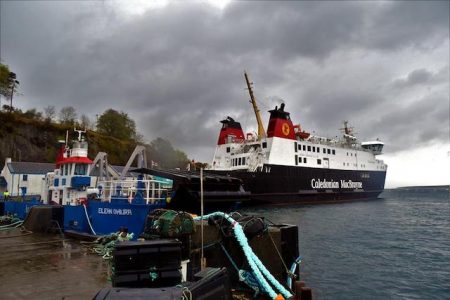
‘The weather seemed to turn against me’: Finlaggan at Port Askaig on 9 May 2018, with Eilean Dhiura. Copyright Mark Nicolson
Wednesday 9 May
This day was the first in which the weather seemed to turn against me and throw my plans askew. Strong southwesterly gales came in from the Atlantic, forcing both Lord of the Isles – which I had intended to sail on that day – and Isle of Lewis to alter their timings. ‘Loti’ sailed for Coll and Tiree an hour early and dropped her crossing to Barra. Isle of Lewis provided a retimed 0520/1030 return sailing from Castlebay to Oban, something she regularly does to avoid the worst of the swells without completely cancelling the service. It was only after Isle of Lewis berthed at Oban mid-morning that I made an alternative plan: I would drive to Kennacraig and catch Finlaggan for a return trip to Port Askaig on Islay.
After heading south to Lochgilphead, I drove through Ardrishaig – where the famous Crinan Canal begins from the south east – and Tarbert, Loch Fyne, before reaching Kennacraig just in time to capture Finlaggan arriving from Port Ellen. Departure wasn’t until 1300, so I had plenty of opportunity to photograph the ship and terminal facilities. After leaving on schedule and heading down West Loch Tarbert, we proceeded across the southern mouth of the Sound of Jura and up the Sound of Islay, reaching Port Askaig at 1455.
Again, the weather was poor, but that did not dampen the pleasure of going ashore for photographs and meeting another enthusiast, Peggy MacEachern, a ‘well kent’ Islay personality. Her husband Arthur was affiliated with Western Ferries as captain of the Jura ferry Sound of Gigha for 30 years, continuing on the replacement vessel Eilean Dhiura from 1998 until his retirement in 2005. Finlaggan, despite looking like a ship a child would play with in the bath, is actually a fine modern vessel, with a shiny interior and an open deck forward of the bridge.
After arriving back at Kennacraig at 1725, I stopped in Tarbert to check if the ferry to Portavadie, Isle of Cumbrae, was sailing, only to find out she wasn’t — whereupon I decided to return to Oban via Inveraray and Loch Awe. I found myself rewarded with awe-inspiring views, including the Crianlarich to Oban railway.
Taking the longer route back to Oban was one of the best choices I made during the holiday. It showed me that, when you are forced to change plan, some quick thinking can offer an alternative that brings just as much joy.
Thursday 10 May
This would prove to be my last day in Oban, at least for this holiday. An early check out of the hotel, and off I went to board my next ferry — Loch Striven for her regular 0645/0745 round trip to Achnacroish on Lismore.
This is the only ferry service operating out of Oban that uses a slipway rather than a linkspan and allows onboard purchase of tickets — handy for those children on Lismore who use the ferry every weekday to go to and from Oban High School, further exemplifying the term ‘lifeline service’.
Outward to the island, I found myself the only passenger aboard, with a vacant car deck I could have played football on. You’d think I had hired Loch Striven for my own personal private charter! Heavy rain showers in the morning left me confined to the accommodation before the sun emerged on my return to Oban.
Following breakfast at the local Tesco, it was onwards to Gallanach to board the newest CalMac vessel, the tiny Carvoria, for a very quick return trip to Kerrera. This is the only CalMac vessel to be powered by two Honda outboards on her stern. Carvoria can take 12 passengers per crossing, and the deck shelter is tiny. A small ramp is lifted by winches before she proceeds on the five-minute skip across to the island where the iconic Hutcheson memorial is situated.
Back in Oban I photographed Isle of Mull arriving and leaving on another busy sailing, but it was Isle of Lewis that I really wanted to focus on. A sizeable contingent of motorhomes, 20 of them, embarked before I drove up the starboard mezzanine deck, where drivers and their passengers are not allowed to leave the car until the deck is fully loaded and securely raised.
Some may find mezzanine decks an inconvenience, but they do provide extra car capacity and don’t spoil the journey once the ship gets going, and that’s exactly how I felt aboard Isle of Lewis as she pulled away from Oban on time at 1330. I was then faced with two ships that looked like they were in a race to be the first to reach Oban — a CalMac Grand Prix between Hebridean Isles and Isle of Mull.
Once the ship was safely out of port, my attention turned to Captain Alex Morrison, whose fine and soothing tones could be heard over the public address system on departure from Oban and again when announcing a crew drill. Invited to join him on the bridge, I made sure to ask him plenty of questions about the current CalMac setup, including how the people of Barra have taken to Isle of Lewis. He instantly declared “The best thing that ever happened to them!”. With capacity quite high on this particular crossing, I could see his point.
Atlantic swells were quite strong once clear of the Sound of Mull, so I headed down to the passenger lounges. About 20 minutes prior to arrival, I returned to the bridge to observe the berthing operation at Castlebay, undertaken in wonderful sunshine.
Friday 11 May
This was supposed to have been the day I travelled home, so it was with some alarm that I discovered that one of the two ships I was relying on, Loch Alainn, was stormbound at Ardmhor all day due to strong southerly swells, following a night of 50-knot winds. This was the first time I had been the victim of such a disruption, but it worked out fine: I was able to re-book my ferry crossings from Ardmhor and Berneray, and a cancellation at the Craigard Hotel meant I could stay the night in the same room. Not only that — I could capture Isle of Lewis arriving in Castlebay in more favourable conditions than first time round. As it turned out, the ship herself brought the good weather back, as blue skies appeared during her final approach to the pier.
Saturday 12 May
Owing to ‘operational reasons’ elsewhere, Isle of Lewis was scheduled to leave an hour and 40 minutes earlier than scheduled — at 0615, against the backdrop of a wonderful sunrise. I had just enough time to get some final photographs, before driving to a packed marshalling area at Ardmhor for Loch Alainn’s 0700 trip to Eriskay. A quick stop was made at Lochboisdale to capture Hebridean Isles arriving for her 0830 sailing to Oban but, given the need to catch the ferry from Berneray, I could not stay for her departure. The varying low and high scenery of the Uists and Benbecula showed magnificently as the clouds vanished out of sight, and I arrived in enough time to catch Loch Portain’s 1025 sailing to Leverburgh. Despite being an uneventful return trip, one person of interest I met and chatted with was none other than Alasdair Allan MSP.
Arriving at Leverburgh at 1125, I realised I might catch a glimpse of Clansman at Tarbert, Harris, where the new pontoons have proved a boon for photographers keen on low level results. Waiting outside for Clansman to clear the berth was the cruise ship Hebridean Princess, which I had seen at Oban only a few days earlier. It was great to see her again, in a different location.
Monday 14 May
After some relaxation at home, I decided to take an additional day off work to add an extra chapter to my holiday diary — a sailing aboard the refreshed Clansman from Tarbert to Uig and Lochmaddy, which I had originally scheduled for 12 May before the disruptions set in. I noticed that, as if to coincide with her 20th anniversary, CalMac had decided not just to remove her lifeboats and have her employ the Marine Evacuation System, but also to give the majority of her internal areas a major refurbishment. The renovations look impressive, giving you the impression of a brand new ship.
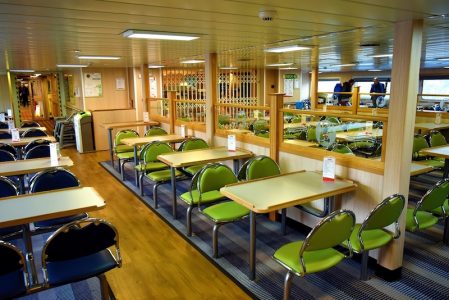
‘I took plenty of photographs of Clansman’s internal improvements’: the refurbished cafeteria on 14 May 2018. Copyright Mark Nicolson
My breakfast roll, toast and cereal on leaving Tarbert at 0720, followed by a delicious Scotch Beef Burger and chips on departure from Lochmaddy after midday, left me in no position to fault the Mariners Cafeteria menu, other than another hike in prices. I took plenty of photographs of Clansman’s internal improvements, which made me conclude that her interior now looks even fresher than that of her younger sister.
Another trip up to a CalMac bridge was in order here, and I was welcomed by Captain Norrie MacDonald and officers Andy Clark and Anna Fraser – two fellow Lewis people. Crews tend to regard the vessel they work on most of the time as the best in the fleet, and Clansman has a large group of fans, including myself. Curious about the various controls on the bridge, I was allowed to launch the stabiliser fins under the waterline that help reduce the rolling sensation on the ship.
Discussing the possibility of further extensions to her open deck areas, now equipped with life rafts where lifeboats once were, we speculated on possible designs that could shelter that particular area or extend the accommodation block on deck four out to the sides and provide a sheltered open deck above, similar to that of Hebrides. We can just wait and see, I suppose.
Reflecting on my eight days of adventure, I drew satisfaction from the fact that I had seen a wide variety of vessels operating out of Oban, had another successful return trip to and from Barra aboard my favourite ship, and found myself with bonuses as a result of an initially frustrating disruption and subsequent reorganisation. From my perspective my holiday had added up to the ultimate CalMac adventure.
MORE IMAGES FROM MARK’S HOLIDAY ALBUM:
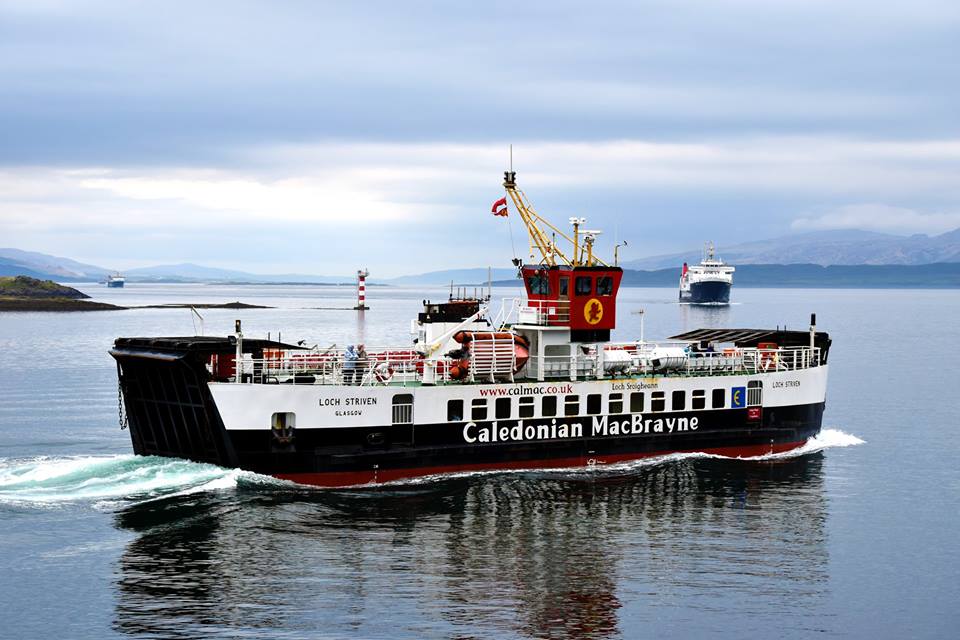
‘I immediately undertook the task of madly photographing as many angles of as many ships as possible’: Loch Striven leaving Oban Bay on 7 May 2018, with Hebridean Isles and Lord of the Isles. Copyright Mark Nicolson
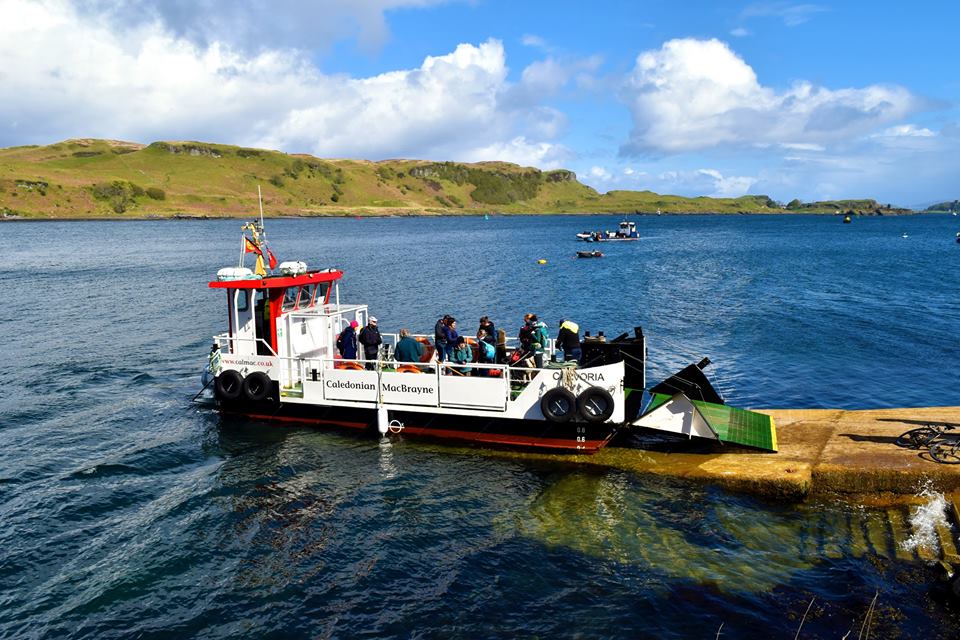
Newest member of the fleet: a quick trip to Kerrera on Carvoria on 10 May 2018. Copyright Mark Nicolson
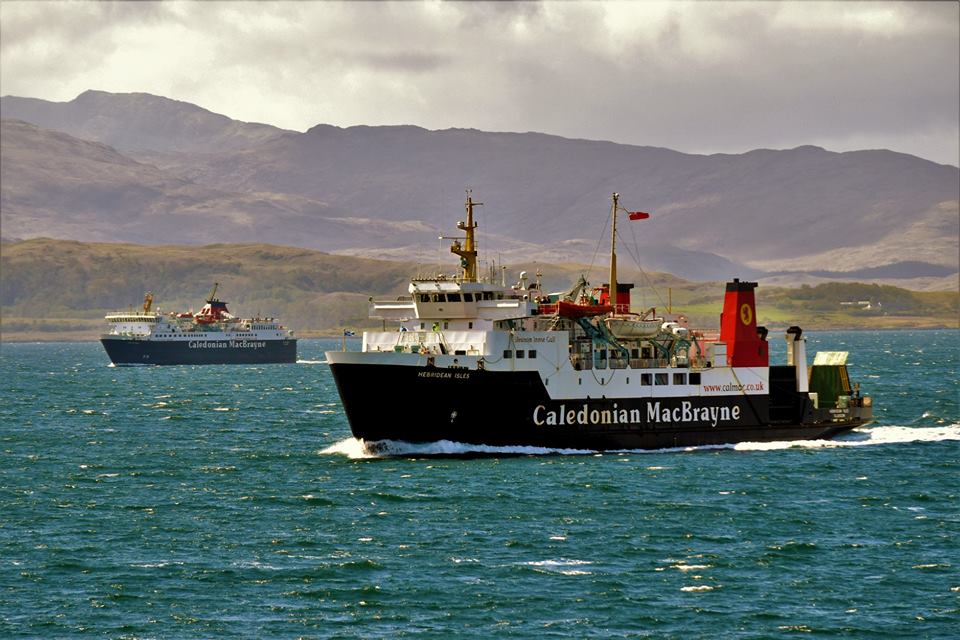
CalMac Grand Prix: Isle of Mull and Hebridean Isles racing for Oban on 10 May 2018. Copyright Mark Nicolson
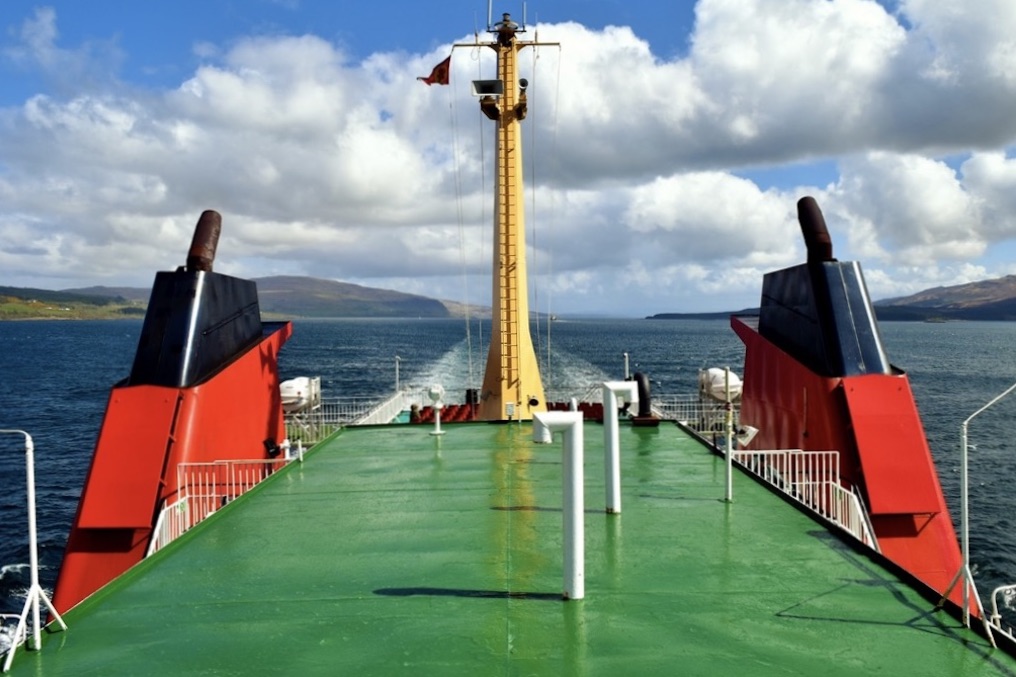
Homeward bound: view aft from the monkey island of Isle of Lewis in the Sound of Mull on 10 May 2018. Copyright Mark Nicolson
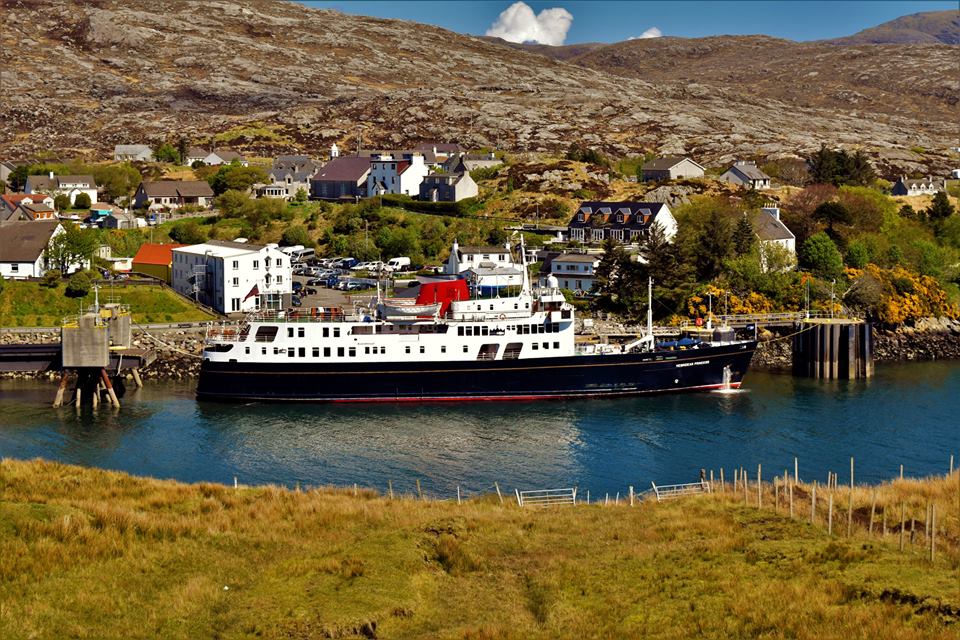
‘It was great to see her again’: cruise ship Hebridean Princess, a periodic visitor to Tarbert Harris in her days as CalMac’s Columba, returned there on 12 May 2018. Copyright Mark Nicolson
Why not join CRSC? It costs just £10 for the first year, and there are many benefits. Click here.













